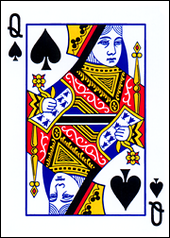Old Maid

You are playing Old Maid with your friend using the queen of spades as the old maid and the through of hearts and diamonds as matching pairs. You are the dealer.
To play Old Maid with people, the dealer deals out all the cards. (In this case, your friend would start with cards and you would start with cards.) Each player looks at his or her hand and discards any matches that were dealt to him or her. Then starting with the non-dealer, the player picks a card from the other player. If that card makes a match with one of the cards in the player’s hand, that match can be discarded, otherwise that card is added to the player’s hand. Then the next player takes a turn by picking a card and either discarding the match or adding the card to his or her hand. The game continues in this fashion until all the matches our discarded, leaving the old maid. Whoever is not holding the old maid at the end of the game is the winner.
The probability that you will win can be expressed as , where and are coprime positive integers. Find .
The answer is 50.
This section requires Javascript.
You are seeing this because something didn't load right. We suggest you, (a) try
refreshing the page, (b) enabling javascript if it is disabled on your browser and,
finally, (c)
loading the
non-javascript version of this page
. We're sorry about the hassle.
This is how I solved the problem. Looking at the solution, there's probably a simpler way.
There are ( 8 1 7 ) = 2 4 3 1 0 possible hands. In my dealt hand, if I have the Old Maid I can have from 0 to 3 matching pairs, if not 0 to 4. My opponent will have the same number of matching pairs. Here is a table of the possible hands I could have, along with the count of ways it can occur:
Each of the cases above has an associated probability that I will win. After the matching pairs are discarded, signify a given position by (a,axt), (at,ax), (ax,at) or (axt,a) where a is the number of unpaired cards in each of our hands, the x is the Old Maid and t signifies whose turn it is. We seek the probabilities of each of the hands above, for example for the first row 3x we need P(1x,1t) because after the deal and discarding 3 pairs, we'd have one card plus the old maid and the opponent has 1 cards and it is their turn.
Note also P(a,axt)=1-P(axt,1) and P(ax,at)=1-P(at,ax) because the chance you will win is the opposite that your opponent will.
Another formula: P(n,nxt)=P([n-1]t,[n-1]x) and P(nxt,n)=P[n-1]x,[n-1]t) because if a person has the old maid on their turn they will keep it and when they take a card it will make a matched pair.
Simplest cases: P(0t,0x)=P(0,0xt)=1 since these are my end winning positions. Likewise my losing positions are P(0x,0t)=P(0xt,0)=0.
From position (1t,1x) I will have a 50-50 chance of picking my opponent's matching card and winning (0,0xt) or their old maid. If I pick their old maid the position becomes (1x,1t). I can then calculate P(1t,1x) by
2 1 ∗ ( 1 − p ) + 2 1 ∗ 1 = p or p = 3 1
Continuing like this it becomes clear that P(n,nxt)= n + 1 n and P(nt,nx)= n + 2 n + 1 , the derivation I will omit.
Finally, it's time to find the answer as the probability of winning as the sum of each (count in the chart)x(probability of winning with that hand)
5 6 0 ∗ 3 1 + 4 4 8 0 ∗ 5 2 + 5 3 7 6 ∗ 7 3 + 1 0 2 4 ∗ 9 4 + 7 0 ∗ 1 + 2 2 4 0 ∗ 3 2 + 6 7 2 0 ∗ 3 + 3 5 8 4 ∗ 7 4 + 2 5 6 ∗ 9 5 = 1 2 5 2 3 3 1
dividing this by the 24310 hands gives my probability of winning as 3 3 1 7 , so a = 1 7 , b = 3 3 and a + b = 5 0
Note: this probability is slightly over 0.5 because I only get 8 of the 17 cards and so have a smaller chance of getting the Old Maid on the deal. I haven't checked it but I'd be willing to bet for a game with n matching pairs the final probability the dealer wins is 4 n + 1 2 n + 1